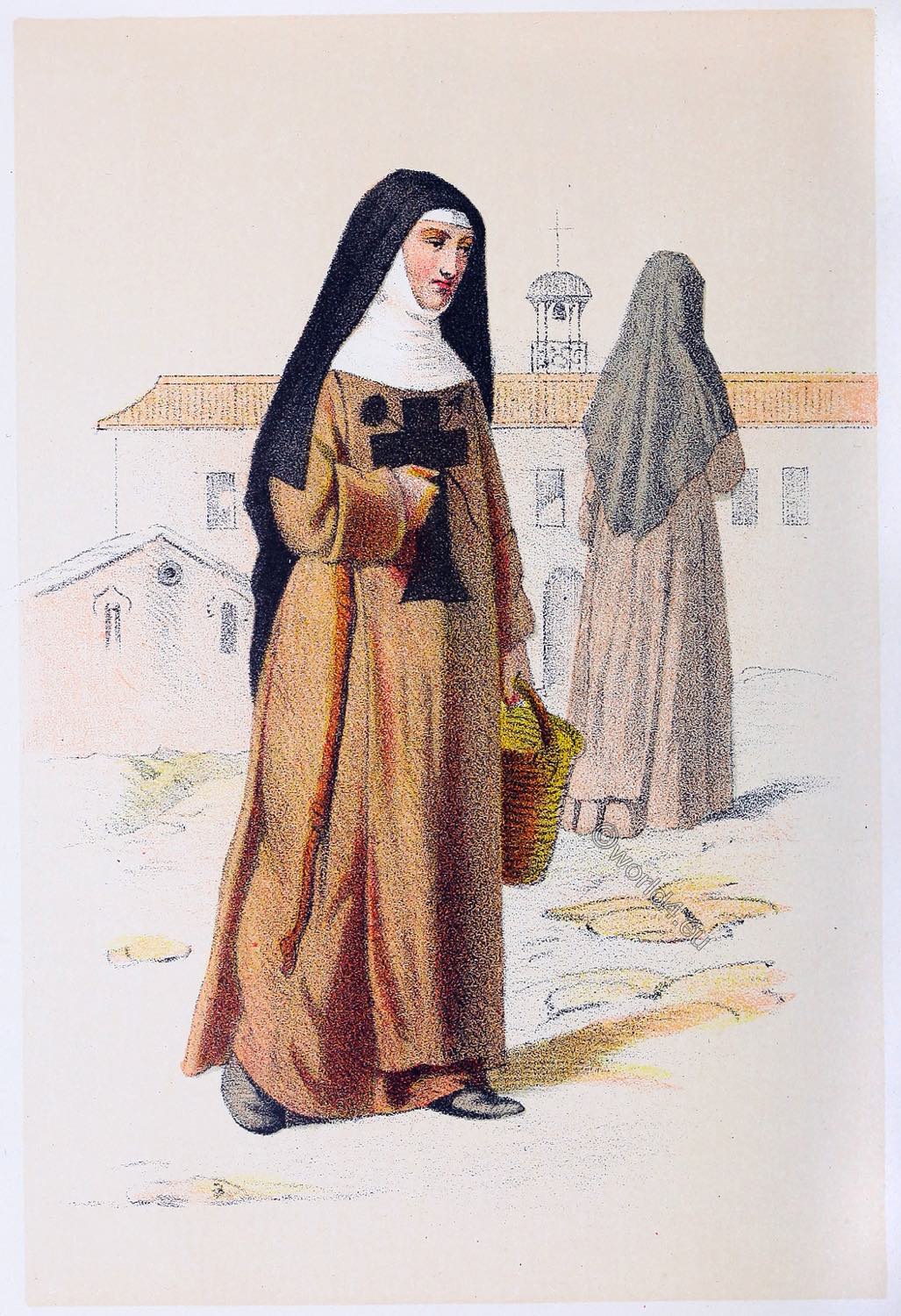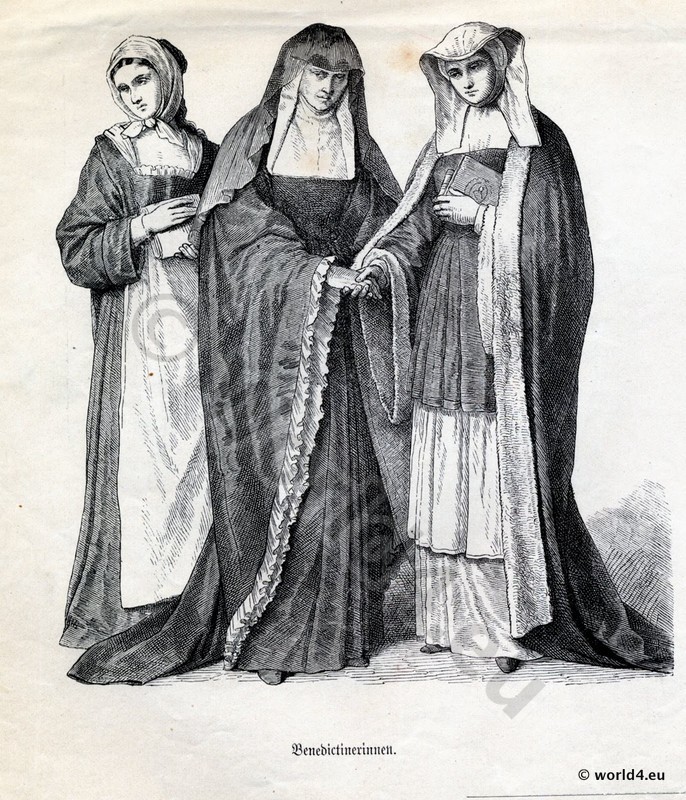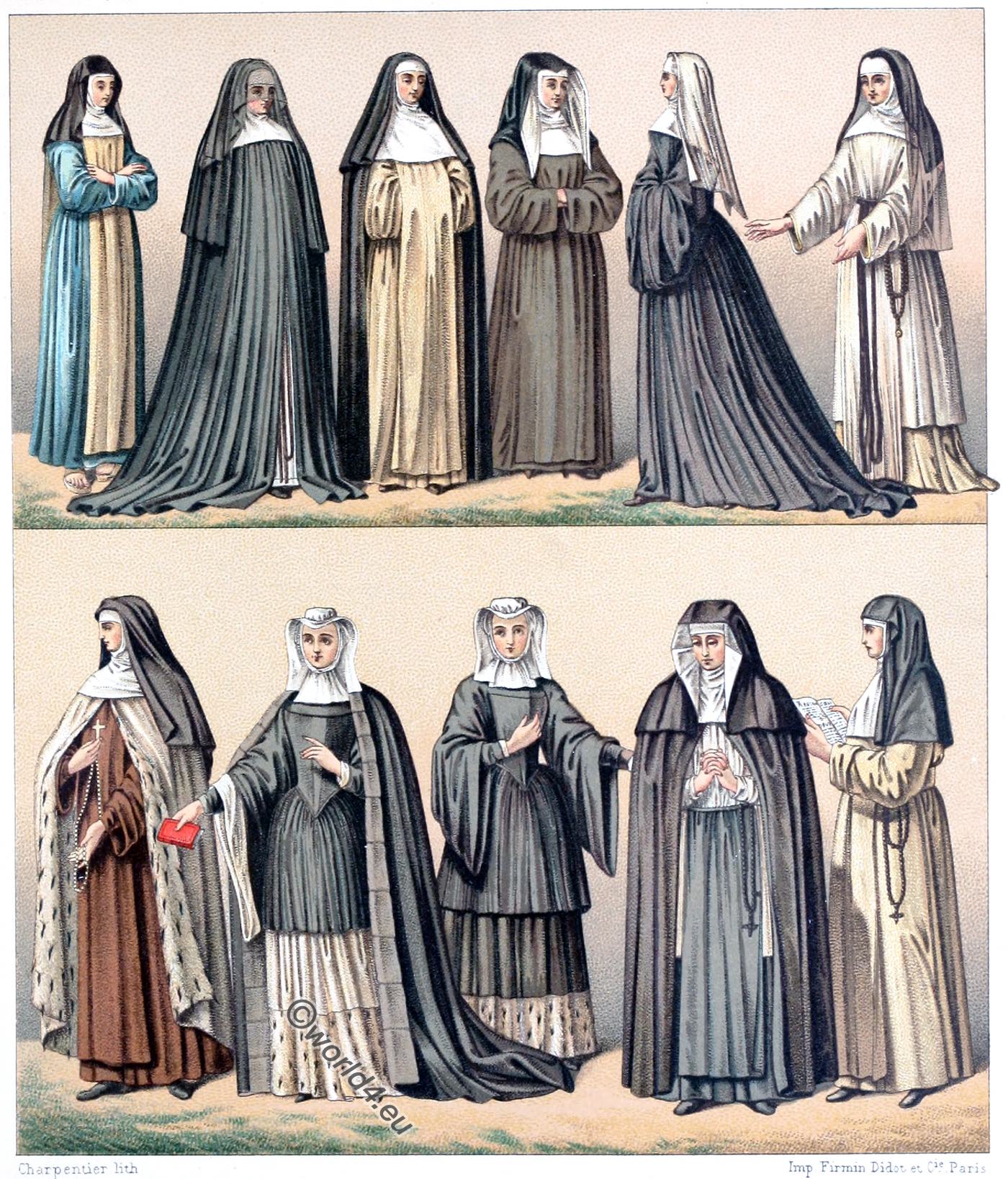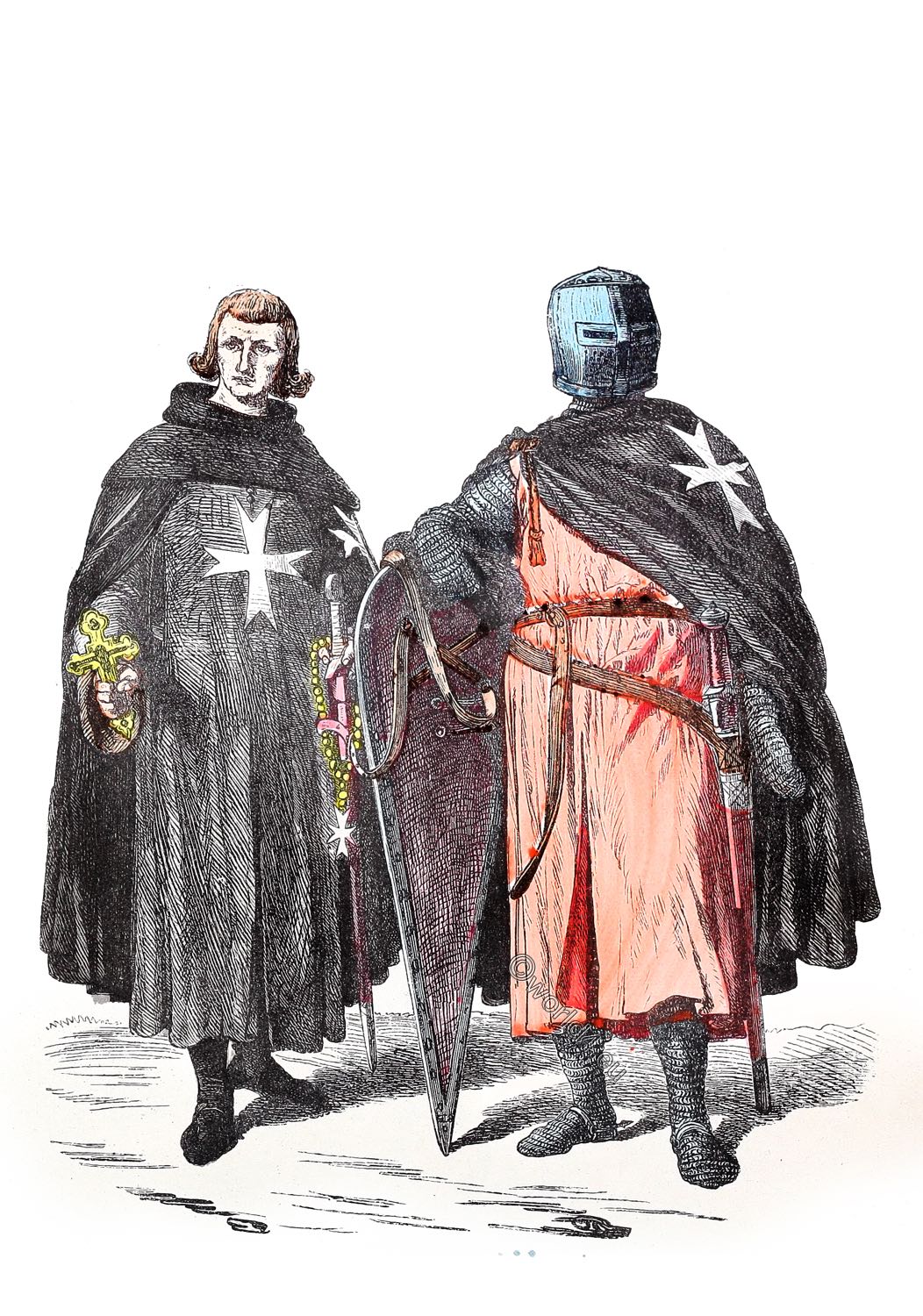ST. ELIZABETH OF HUNGARY. – BLESSED ANGELINA OF CORBARA. – HOSPITALLERS. -VARIOUS CONGREGATIONS.
FEMALE RELIGIOUS CONGREGATIONS OF THE THIRD ORDER OF ST. FRANCIS.
THE first female Tertiary of the Order of St. Francis to take solemn vows was St. Elizabeth of Hungary, born in the year 1207. She married Louis, landgrave of Thuringia, and in the matrimonial state, as well as during the time of her maidenhood, she led the life of a saint. She was the first person in Germany to enter the Third Order of St. Francis, which had shortly before been established.
After the death of her husband, in 1227, she was violently deprived of her states, and even driven out of her palace, but the humiliations she endured drew her nearer to God, and, having entered the church of the Friars Minor, she besought the brethren to sing the Te Deum *) to thank the Divine Majesty for having sent her those crosses.
The saint died on November 19, 1231. Although St. Elizabeth of Hungary does not appear to have founded an order, the Regular Franciscan Tertiary Nuns agree in considering her their mother and patroness, as she took the habit of St. Francis, bound herself by vows, and, as some authors assert, entered into a monastery.
*) Te Deum (from Latin Te Deum laudamus, “Thee, O God, we praise”) is the beginning of a solemn Latin song of praise, thanksgiving and supplication of the Christian church. It probably originated in the 4th century, the author is unknown.
The acknowledged foundress of the nuns of the Third Order of St. Francis is Blessed Angelina de Corbara. She was born in 1377 in the kingdom of Naples, and from her earliest years gave evidence of the greatest piety. In obedience to the will of her father, she married the count of Civitella, but without prejudice to her virginity, for both herself and her husband bound them selves by a vow of chastity, and lived as brother and sister. After the death of the count, Angelina, together with her maids, took the habit of the Third Order of St. Francis.
After enduring many persecutions, she founded a monastery of the Third Order at Foligny, with the consent of the Bishop and of Pope Boniface IX., in 1397. In 1421 her religious, with permission of Martin V., began other foundations in various parts of Italy. The same Pope, by a Bull of 1328, united all these monasteries into one congregation, permitting the nuns to elect one of their number as Superior General, who was at the same time to be subject to the General of the Friars-Minor of the Observance.
In 1459 the office of General in their congregation was suppressed by Pius II. They nevertheless remained subject to the Observantines until 1481, when they passed over to the jurisdiction of the Amadeists, who also formed part of the Franciscan family. But these latter religious being suppressed, some of the convents of the nuns returned to the jurisdiction of the Observants, while the rest became subject to the Bishops of their respective dioceses.
Blessed Angelina had died many years before, in 1435, in her convent of Foligny. The monasteries of her order began gradually to follow different observances, being placed under separate jurisdictions.
Almost from its infancy the Brethren and Sisters of the Third Order had begun to devote themselves to the care of the sick, and thus various congregations of Hospitallers were formed among them, such as the Obregons for men. The Sisters bound themselves by solemn vows from the beginning of their institution, and belonged to various congregations bearing different names. Some attended to the sick outside of their convents, while others administered to them only in hospitals, and they were therefore known as Hospitallers. Many of them bore the name of Grey Nuns, from the color of their habit, although in various convents this color was afterward changed.
We have seen that a reform had been introduced among the Tertiaries of France, which obtained the name of Congregation of Picpus, from its monastery at Paris (founded by Father Coudrin, b. at Coursay-les-Bois, in Poiton on 1st March, 1768). A similar reform was about the same time introduced in that country among the female religious. These nuns of the Strict Observance suffered greatly during the French Revolution, but they were again established in France in our century.
Another reform among the nuns of the Third Order was that of the Recollectines (Religieuse du Tiers Ordre de St. Francois, dite Recollectine). It was established in Belgium in the seventeenth century. Numerous other congregations of women belonging to the Third Order of St. Francis, of which the members bind themselves by simple vows, have at different times been established.
Among these we mention the Franciscan Sisters at Heythuizen, in Holland, who devote themselves to the education of youth; those of Aix-la-Chapelle, whose object is the care of the sick in their houses and in hospitals. The Sisters of Aix-la-Chapelle possess flourishing establishments in this country and, among others, St. Peter’s hospital in Brooklyn, N. Y. A congregation of Franciscan Tertiaries has a motherhouse at Syracuse, N. Y.; their principal occupation is teaching and the care of the sick. They have branch establishments in the Sandwich Islands, and attend the lepers on the island of Molokai.
A congregation of the Third Order of St. Francis was established in Philadelphia, on April 9, 1855, by the servant of God, John Nepomucene Neumann.*) This saintly man, the cause of whose canonization has been introduced, was born at Prachatitz in Bohemia, on March 28th, 1811. He came to America while still an ecclesiastical student, and he was raised to the priesthood by Bishop Dubois of New York, on June 25, 1836. He labored as a secular priest in the northern portion of New York state until 1840, when he became a Redemptorist (Congregation of the Most Holy Redeemer (Latin: Congregatio Sanctissimi Redemptoris; CSsR). After filling various positions of trust in the congregation, in 1852 he was appointed Bishop of Philadelphia.
On a visit to Rome he expressed to Pius IX. the desire of introducing Dominican Sisters into his diocese. The Holy Father hereupon advised him rather to establish a branch of the Franciscan order. On his return to America he immediately set to work, and called from Germany the Conventual Franciscans in order to form the members of his new institute. The little community of Sisters consisted of five members, of which Mother Mary Frances was the Superior. The Bishop himself prepared their constitutions. Four years after its establishment the new congregation possessed four houses, devoted to the care of the sick and the instruction of youth.
*) John Nepomucene Neumann is a saint of the Roman Catholic Church since 1977. He is the first US bishop to be canonised.
A new compilation of rules and constitutions was drawn up in the year 1880. The fundamental rule of the congregation is that of the Third Order of St. Francis. The Sisters labor especially for the Christian renovation and elevation of family life among the poorer and lower classes of society. They educate youth in parochial schools, and care for the sick in public institutions, as well as at their homes. They also accept the care of orphan asylums and other similar works of charity.
The mother-house of this congregation is in the city-of Philadelphia, and the Archbishop of that See confirms the election of the General Superior, and gives permission for the reception of the Sisters to their profession. No house of the congregation may be founded, either within the diocese or outside of it, without his permission.
This congregation possesses houses not only in the diocese of Philadelphia, but also in those of Baltimore, Trenton, Harrisburg, Oregon City, the Indian Territory, Nesqually, and others.
The saintly founder of the congregation, Bishop Neumann, died on January 5th, 1860.
Source: History of religious orders. A compendious and popular sketch of the rise and progress of the principal monastic, canonical, military, mendicant, and clerical orders and congregations of the Eastern and Western churches, together with a brief history of the Catholic church in relation to religious orders by Charles Warren Currier. New York, Murphy & McCarthy, 1894.
Related
Discover more from World4 Costume Culture History
Subscribe to get the latest posts sent to your email.








